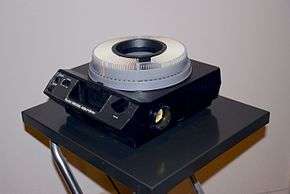Carousel slide projector

A carousel slide projector is a common form of slide projector, used to project slide photographs and to create slideshows. It was first patented on May 11, 1965, by David E. Hansen of Fairport, NY. Hansen was an engineer at the Eastman Kodak Company.[1] The original Carousel S Slide Projector was invented by Italian-American Louis Misuraca, who brought his design to the Kodak company, selling it for a lump sum. The design was refined by Hans Gugelot and Reinhold Hacker for Kodak AG in Stuttgart in 1963, and is part of the permanent collection at MOMA, New York.[2] [3]
Physical form
A separate, circular tray holds several (usually 80 or 140) 35mm slides, and is filled with each slide placed in upside down and backwards, so that the image is presented with the correct orientation. The tray has a metal plate on the bottom with an opening about 5 mm wide barely long enough to pass a single slide to the projection gate below it.
The projector body contains a motor which rotates the plastic main body of the tray (containing the slides) while the metal plate is fixed with the opening over the projection gate. As the tray is advanced, a reciprocating mechanism pushes the currently loaded slide back out into the tray, then the tray is rotated, dropping the next slide into position between the light source and lens.
A common series of carousel projectors with a horizontally mounted tray was introduced in the spring of 1962 by Kodak (Kodak Carousel/Ektagraphic). The earliest Carousel models (mostly known as the 500-series) are compatible only with the 80-slide trays.
The Kodak system offered three advantages over the straight-tray, horizontal-feed systems that were then common on the market. The Carousel tray held slides in place with a locking ring on its hub, preventing slides from accidentally spilling out of the tray if it was dropped. By using gravity to lower the slide into the projector, the chance of jamming was greatly reduced, since a warped slide would not descend past the point at which it encountered resistance in the mechanism. The circular tray also enabled the projector to display automated shows without the need to manually reset the slide tray between performances.
Kodak also offered a stack loader that allowed running a stack of up to 40 slides without using a tray, but forward only; and clip sets holding up to 36 slides per clip. A box of 12 clips could store up to 432 slides, and keep them organized.
During the 1970s, Kodak also produced a Pocket Carousel projector for use with miniature 110 format Kodachrome slides.[4][5]
The Kodak Carousel projector was discontinued in October 2004.[6]

Less well-known but plentiful is a family of projectors based around a design originated by Sawyer's and later sold under other brand names. That manufacturer's first slide projectors, in the late 1950s, had used straight trays. In 1963, the Sawyer's Rotomatic, the first version using circular trays (called Rototrays), was introduced. These are distinguished by the round tray being in an upright orientation, like a Ferris wheel. Unlike the Carousel tray's use of a locking collar to hold the slide in the tray, the Rototray held slides in place using friction against the side of each slide. Projectors using the 100-slide Rototray were backward-compatible with the TDC-Universal straight slide trays that had been popular since the late 1950s.[7] The 1960s would also see the introduction of a plethora of less popular tray designs, most incompatible with each other, introduced by manufacturers possibly hoping to profit from the Razor-and-blades business model.
In popular culture
The Kodak Carousel slide projector was part of the plot of the 2007 episode "The Wheel" in season 1 of the TV series Mad Men. In the episode, the advertising agency comes up with the name "Carousel", in place of the Kodak executives' name for it, "The Wheel", pitching the device as a nostalgic conveyance that let its viewers travel through their memories as a child would, "around and around and back home again to a place where we know we are loved".[8]
References
- ↑ "Combined slide projector and slide tray". Google.com/patents. Retrieved 2014-02-07.
- ↑ MOMA: Slide Projector by Gugelot
- ↑ The New York Times
- ↑ Marcus, Ted R., APS, 110, "Disc," and Formats du Jour, Ted Marcus' Virtual Light Table. Article copyright date 2006, retrieved 2006-11-09.
- ↑ Marcus, Ted R., Europe Through the Front Door, Ted Marcus' Virtual Light Table. Article copyright date 2004, retrieved 2006-11-09.
- ↑ Kodak Slide Projectors, kodak.com corporate website. Article claimed frozen as of November 2004, retrieved 2006-11-09.
- ↑ Popular Photography magazine, July, 1964, p.5
- ↑ https://www.youtube.com/watch?v=MoKtk8L77-U
External links
- Kodak: Slide projectors family
- Kodak Slide Projector on Porter Electronics (Website where they are still available)